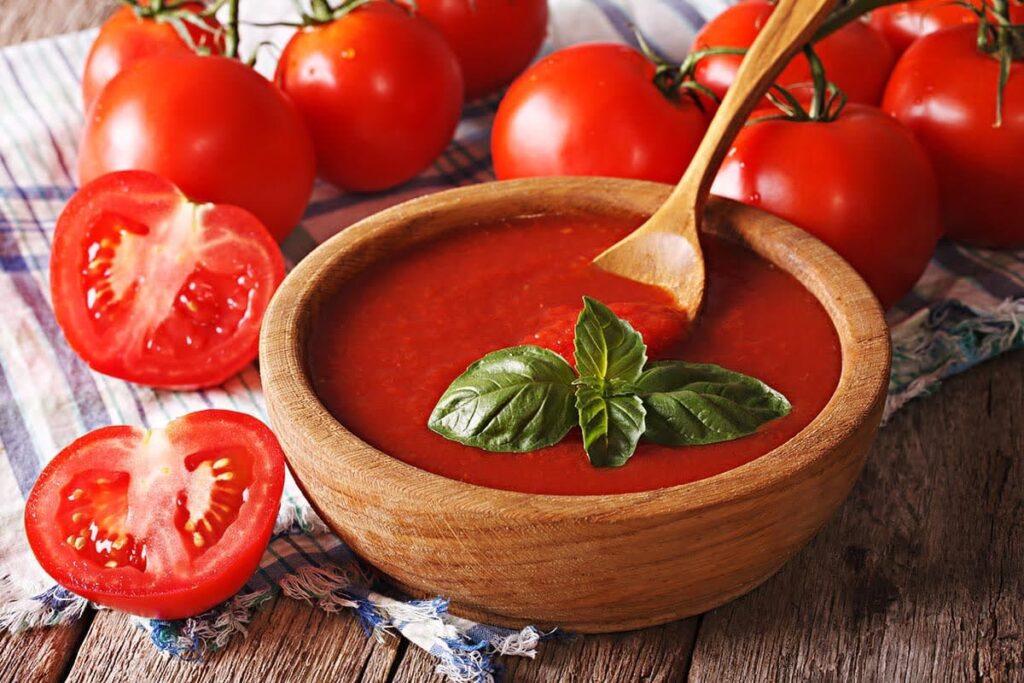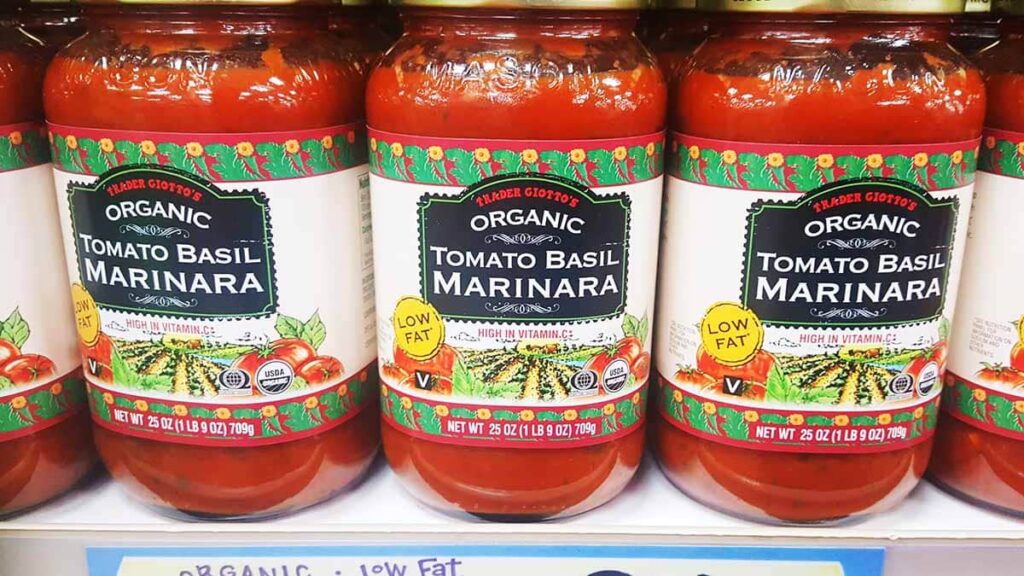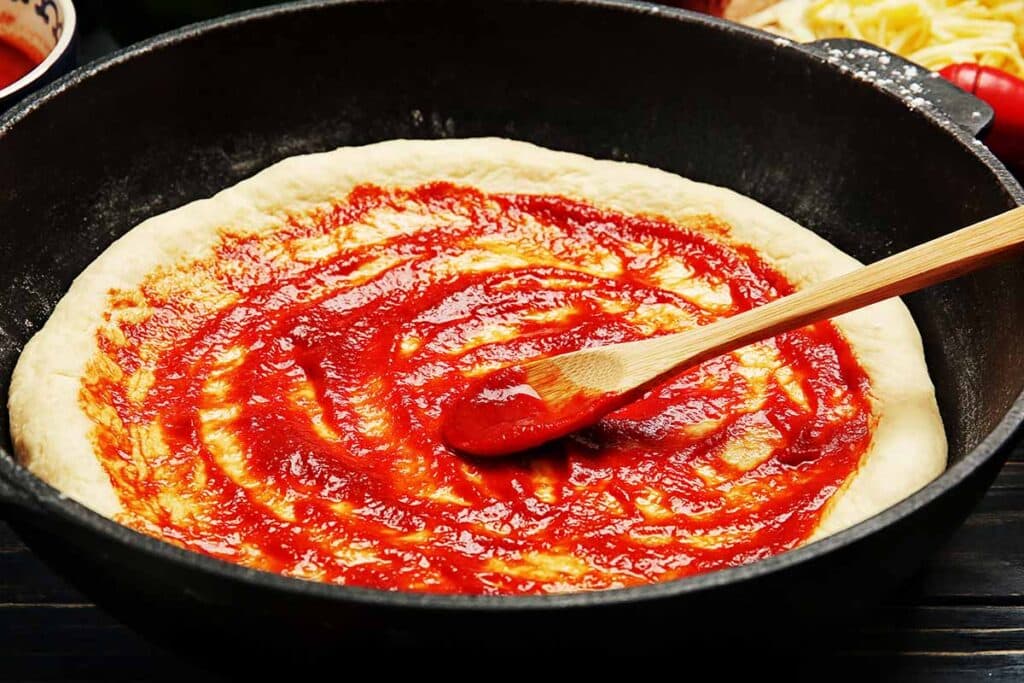If you’re a foodie, wondering about food and the different food facts. Things like pizza vs marinara will keep you curious until you get a convincing answer.
And that’s okay because we, too, wonder what goes into pizza besides our favorite pizza toppings? Why the pizza sauce is so good, and what makes it so delicious?
Read on to find out the similarities and differences of these two tomato sauces.

If you love pizza, then you know what pizza sauce is.
Only that delicious sauce on your pizza gives it its uniquely rich and tasty flavor.
You can trace the roots of pizza sauce to the Italians’ classic Neapolitan pizza.
They made it with tomatoes, garlic, basil, oregano, and olive oil.
The cooks used it on pizzaiola before it became known worldwide as a base or topping for pizza.
Combining these essential ingredients creates a genuinely flavorful pizza sauce and a perfect base for all kinds of pizza.
Traditional pizza sauce is typically made with tomatoes, garlic, onions, and some herbs and spices.
But did you know you can add other ingredients to pizza sauces based on your preference?
Throw in some red pepper flakes for extra spiciness or brown sugar to make it sweet.
If you prefer something other than a tomato-based sauce, you can try pesto, Alfredo, ranch, barbecue, and hot sauce, which are very popular with pizza lovers.
Some even use mayonnaise as a pizza sauce.

Marinara is a famous red sauce in Italian cuisine that uses tomatoes as the base ingredient.
Like pizza sauce, you can trace the history of marinara sauce to classic Neapolitan cooking.
The Italians prepared marinara sauce using essential ingredients like tomatoes, basil, and garlic.
There are many stories about how this particular sauce became known as marinara.
But it doesn’t have anything to do with fish or seafood.
The most famous story is that it was the preferred meal of marinari (the Italian word for sailors) coming home to Italy after long sea expeditions.
Marinara is a versatile sauce.
You mainly use it as a sauce for spaghetti and other tomato-based pasta.
Moreover, it makes a delicious sauce for ground beef, meatballs, fish, or chicken.
It even makes a terrific dipping sauce for bread and mozzarella sticks!
These days, you can buy ready-to-use, pre-cooked marinara, and pizza sauce at supermarkets so that you can make pizza or pasta anytime.

You may think that pizza sauce and marinara are the same since people always use them for Italian dishes.
But these famous Italian sauces have a main difference, even if they’re both tomato-based sauces.
Pizza sauce is explicitly formulated for pizza.
It’s typically made from crushed tomatoes, so you get a looser and thinner consistency to spread easily on the pizza dough.
Pizza sauce has a rich flavor even with just a few ingredients.
For an enhanced flavor, you can use herb seasonings such as basil and oregano.
Pizza sauce works well with the moisture of pizza dough, and it can hold up against high heat.
You don’t need to cook it, and there’s no need to simmer it in a pot.
Just puree it loosely, and it will finish cooking once the pizza is baked in the oven.
Meanwhile, marinara offers more versatility―you can use it in many pasta dishes, casseroles, stews, and even dipping sauces.
You typically use whole tomatoes (fresh or canned) to make marinara sauce, which produces a thick consistency that easily coats pasta noodles.
As for taste, it has a more honest-to-goodness tomato flavor, which usually comes from ingredients such as tomatoes, olive oil, garlic, salt, and black pepper.
Compared with pizza sauce, marina has a more complex flavor.
Unlike pizza sauce, marinara needs to simmer to thicken the sauce and develop and draw out the flavors.

Whether you’re making delicious pizza sauce from scratch or getting the store-bought ones in cans or jars, here are its most common ingredients:

Apart from making pizza and other dishes that taste like pizza, such as pizza rolls, pizza sandwiches, and pizza noodle bakes, you can use it for:
Opt for San Marzano tomatoes if possible. They are known for their sweet, rich flavor and low acidity.
If using canned tomatoes, choose whole, peeled tomatoes and crush them by hand or with a blender for a better texture.
Use fresh herbs like basil, oregano, and parsley for the best flavor.
Fresh herbs should be added towards the end of cooking to preserve their brightness.
If using dried herbs, crush them between your fingers before adding to the sauce to release their aroma.
Taste the sauce as it simmers and adjust the seasoning as needed.
This may involve adding a pinch of sugar to balance acidity or a bit of salt and pepper for flavor enhancement.
A small amount of balsamic vinegar can add depth and sweetness to the sauce.
For a smooth marinara sauce, use an immersion blender or food processor to puree it after it’s done cooking.
If you prefer a chunky sauce, you can skip the pureeing step.
Like pizza sauce, marinara’s ingredients are easy to find and usually consist of tomatoes and seasonings.
Here are the most commonly used ingredients when making marinara:

Not sure what other dishes you can make with your marinara sauce?
Here are some of the most popular options that will be a hit with everyone.
It’s always a good decision to go fresh with your ingredients. But it’s time-consuming and labor-intensive.
Not all ingredients will often be in season, so this can be a problem if you love to eat pasta any time of the year.
That’s why it’s sometimes better to use canned tomatoes to make your sauces faster.
Just avoid the flavored canned tomatoes so you can add your preferred spices or seasonings.
Marinara sauce should not be too smooth, so make sure it has texture to coat better on pasta.
Make a chunkier marinara sauce by not using a blender or food processor.
Just dice the tomatoes and crush them using a fork or a spatula.
Use different vegetables like carrots, celery, garlic, and onions to achieve an exciting mix of flavors and textures.
Just make sure they won’t overpower the sweetness of the tomatoes.
Some great options include aromatics and spices.
Don’t rush the process; allow enough cooking time for your dish.
Once you add your tomatoes to the pan, avoid overcooking by simmering for 20 minutes.
Reduce the sauce but concentrate on the flavor.
Yes, you can substitute marinara sauce for pizza sauce, especially if you have no time to buy it at the supermarket.
If using pizza sauce as marinara, reduce the amount of sauce in your pan, and then add some minced garlic and herbs like basil, oregano, and Italian seasoning.
As it’s typically both tomato-based, they share a similar taste. But because they have different preparations, they also have a slightly different flavor. Pasta sauce, like spaghetti sauce, is slow-cooked, while pizza sauce doesn’t need to be cooked.
Pizza sauce, of course. It has a looser, thinner consistency, making it very spreadable on pizza dough. And you don’t need to cook pizza sauce.
We recommend using marinara as pasta sauces need to cook over heat. Marinara also has more flavor, which makes it the best choice for pasta noodles and other boiled or cooked food.
If you store your pizza sauce or marinara at room temperature, it can last up to five days. You can also freeze your sauces, and it will be good for up to three months.
However, it will still depend on your raw vegetable ingredients for the sauces. To be safe, label your sauce container with the date you made and stored it.
When it comes to pizza sauce vs. marinara, it’s all a matter of personal preference.
Whether trying to achieve the authentic flavors of a classic Italian dish or enhance the flavors of your usual pizza toppings, try to switch things up and use pizza and marinara sauces to know which you like better.
Now that you know more about pizza sauce vs. marinara, you can use these two sauces creatively with your dishes to give them that unique twist!





